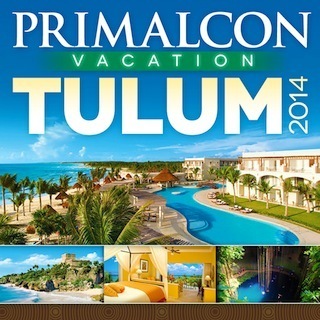Mark Sisson's Blog, page 316
December 12, 2013
Do You Use Food As a Crutch?
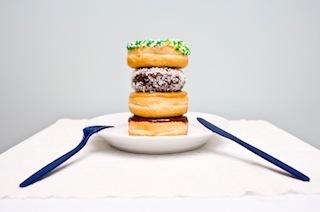 I really enjoy eating. I think many of us do, especially after we’ve been on our Primal journeys for a while and have expanded our cooking talents into new creative territory. My opinion is food can and should make us feel good. It’s part of our evolutionary fabric. We eat for survival but also for enjoyment just as our ancestors did. Our very physiology is set up for it, in fact. We’re treated to a feel-good hit in our brain’s pleasure centers when we eat. That said, we sometimes get emotional satisfaction from the deal as well. For example, while not every meal needs to be a monumental creative accomplishment, those that are offer a unique satisfaction that goes somewhat beyond the physical. Other times, it’s not so much a culinary feat but a familial/cultural tradition that magnifies or deepens the satiation. (This time of year, of course, is prime time for sentimentalizing food – for better and worse.) Still other times, however, the emotional component is less a side bonus than the initial impetus. We’re drawn to eat because of our emotions. (And here’s where we begin to get ourselves in trouble….)
I really enjoy eating. I think many of us do, especially after we’ve been on our Primal journeys for a while and have expanded our cooking talents into new creative territory. My opinion is food can and should make us feel good. It’s part of our evolutionary fabric. We eat for survival but also for enjoyment just as our ancestors did. Our very physiology is set up for it, in fact. We’re treated to a feel-good hit in our brain’s pleasure centers when we eat. That said, we sometimes get emotional satisfaction from the deal as well. For example, while not every meal needs to be a monumental creative accomplishment, those that are offer a unique satisfaction that goes somewhat beyond the physical. Other times, it’s not so much a culinary feat but a familial/cultural tradition that magnifies or deepens the satiation. (This time of year, of course, is prime time for sentimentalizing food – for better and worse.) Still other times, however, the emotional component is less a side bonus than the initial impetus. We’re drawn to eat because of our emotions. (And here’s where we begin to get ourselves in trouble….)
On a day to day basis, many of us might not automatically identify our patterns with emotional eating, per se. We might use food in a crutch-like, but not overtly emotional way like downing a couple cups of coffee each day for a continuing energy boost or unwinding from the day with a regular glass of something alcoholic (for me it’s having a single glass of wine most nights). In these and many other cases, they’re foods we “use” without problematic consequences. Likewise, now and then we just crave something non-Primal and allow ourselves the option. There’s no Primal police force ready to sound the alarm if you eat off the PB grid. I’m not on a mission to “normalize” orthorexia. Not every dietary indiscretion or indulgence suggests some deeper psychological issue. Sometimes a cookie really is just a cookie.
On the other hand, many of us have turned to food at some point to stifle or distract our emotions. We might eat at night out of abject boredom – or deep loneliness. Maybe it’s stress or anxiety, and food feels like an emotional salve in the moment. We’re sick, and we want comfort food. We’re in physical or emotional pain, and we just want something to take our minds off the discomfort for a while. Difficult times or transitions leave us feeling empty, and food becomes the filler or coping mechanism for a few days or maybe a few weeks (or several years). In these ways, emotional eating stands on its own in a stark way and substitutes for something bigger than what could be contained on the plate.
The fact is, food has tremendous power to heal, to enhance our enjoyment of life, to change us mentally and physically. We know this all too well in the MDA community. But when we begin to use food for these emotional triggers, we can over time begin wading into self-destructive or at least self-defeating behavior. When it becomes a regular pattern not only does our health suffer, but we suffer emotionally by putting off addressing what’s behind the impulse. As a general principle, we too often seek out the food related hit to our pleasure centers when we’re short on other pleasures in our lives. That leads us to the question of what to do when the emotional impetus creeps in….
Accept the biology of the situation.
Yes, food trips our feel-good trigger. We’re even hormonally wired to seek out typical comfort foods based on the interaction of stress with ghrelin levels. And our minds aren’t deceiving us about the stress relief. Research shows it can, in fact, inhibit our brain’s anxiety response. That said, there are any number of ways to achieve the same thing. No, it’s not in your head, but there’s a better way to work the system.
Hit the pause button.
Just stop. Stop yourself from walking to the fridge. Stop your thoughts. Go clip your fingernails. Brush the dog. Vacuum or shovel. Throw in a load of laundry. Feel a little gripped? Okay, you’re ready for the next point.
Assess what’s really going on.
Check in with yourself – recent past, immediate present, near future. Put it in the starkest, most blunt terms you can. Use profanity if desired. Have you had a really (blank) day? How has this week been for you? Are you worried about that (blank) project coming up at work or how the (blank) you’re going to pay for an upcoming trip or home repair? Even better – have a checklist. Journaling serves its purpose, but there’s something about the simplicity of a checklist (kept on the fridge perhaps) that stares back at you with immediate clarity. Write the day and check off what triggered the (blank) cravings.
Get your needs met.
Especially if this is a frequent occurrence, what is food standing in for? What’s going on emotionally that needs tending? For some, it might be as simple as taking some time off work, spending personal time in a more quality-oriented way (as in fun), or tweaking your schedule, commitments, or budget. For others, however, the impetus toward emotional eating isn’t just situational. It’s a deeply rooted association that has perhaps built up over years or even decades. Finding an experienced therapist and/or relevant support group can be key. Don’t force yourself to keep stuffing down the impulse. Unpack it. Bring it into the light of day to live unburdened by it.
Have a different kind of menu for these moments.
Again, post it on the fridge. Put a copy in your desk, your car, your purse, your briefcase, and wherever else you need it. When you’re “hungry,” (as in not), look at the list of other things you can do to make yourself feel good in the moment. Have at least ten things you can do. Add to it whenever you’re so inspired.
Finally, let me say one last thing about an emotion I don’t believe should have any place in eating. That’s guilt. I’d venture to guess that more misery has been been experienced and more pounds added from guilt than most feelings. It’s a cruel but telling irony. We eat what we know we shouldn’t and perhaps even really don’t really want to. Then we wallow in guilt, which leads to shame, which circles back to isolation and insecurity, and right back to the impulse to fill the emotional hole again. While we can’t change the past (whether it was five years or five minutes ago), we can work to cut off the cycle we find ourselves in. Cut it off at guilt.
This isn’t to justify the undesirable choice. You’re not justifying it or condemning it. Don’t tell yourself anything about it in fact. Conversing with our impulses rarely if ever helps. Circumvent the mental chatter altogether. (It does nothing but takes you down a rabbit hole.) Come back solely to the sensory and physical. Do something (other than eating) to get back in your body. Yup, the very one you’re probably looking at with more frustration or disappointment or disgust or self-loathing than you had before you ate the thing-you-emotionally-ate. Go against every instinct you may have and do something good for it – something healthy or indulgent or aesthetically pleasing. Put on something you look good in. Trim your beard. Go for a walk. Take a hot bath. Go float in the ocean or lay in the grass. Paint your nails if that’s your thing. The point is, realign your thinking in that specific moment. The cookie is gone unless you’re still carrying it around in your head. Let it go. The rest of the day is waiting.
Thanks for reading, everyone. Do emotions influence your eating? What’s been the best solution for you? Share your thoughts and strategies.
Order The Primal Blueprint Starter Kit and Take Control of Your Health Today!

December 11, 2013
Introducing Death By Food Pyramid
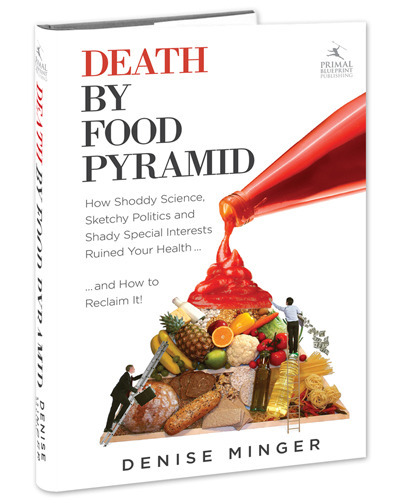 Today marks the release of the book for which you’ve all been waiting patiently or impatiently (I’ve got the emails to prove it!), and with it a very special limited-time offer (see details below). But first, let me tell you how we got to this point.
Today marks the release of the book for which you’ve all been waiting patiently or impatiently (I’ve got the emails to prove it!), and with it a very special limited-time offer (see details below). But first, let me tell you how we got to this point.
About three years ago, Denise Minger – a statistics-savvy English major in her early 20s – set the nutrition world ablaze with her careful, methodical parsing of the data behind The China Study. As your probably know, The China Study is that “authoritative” tome that vegans and vegetarians carry around as an instant comeback to any omnivore who dares assert the healthfulness of consuming things with faces. I was very impressed with her ability to take otherwise overwhelming data sets and pull out conclusions that were equally – if not more – valid than what the research scientists were culling from their own studies. Her China Study takedown was the capper. We met for lunch and I pitched her this idea of a book that would inform and educate the general public as to how we have been misled by the “authorities” (public policy makers and researchers) and which would deconstruct the precise history and point out the failed logic, so that anyone could see what a disaster the pyramid was. I wanted it to appeal to everyone – not just Primal/Paleo – as an empowering tool. Death by Food Pyramid is the long-awaited result, and it more than succeeds in achieving its goals.
On these very pages, you’ve seen her dissect the flawed science pointing the finger at red meat’s homicidal tendencies and a low-carb diet’s predisposition to give you heart attacks. You’ve marveled at her witty deconstruction of the purportedly inevitable conclusions to a high-fat diet – type 2 diabetes and breast cancer - as well as the claimed life-extending effects of whole grains. And when you worried whether fish oil would give you prostate cancer, Denise was there to quell your concern. Now, with this book, she sets her sight on the disastrous, farcical USDA Food Pyramid, exposing the twisted liaisons between government and industry that enabled it and dismantling the shoddy science and erroneous conclusions supporting it.
Ultimately, Death by Food Pyramid is about empowering you, the consumer, the eater of food, the arbiter of what goes in your mouth, to make the right choices and bypass the middlemen when it comes to interpreting science. That’s what Denise has been doing throughout her short but eventful career, and now she’s giving you guys – the readers – the keys to the kingdom.
Of course, empowerment doesn’t come easy. It’s not instantaneous. Troubling emotions will arise as you read. You’ll feel shock – at what passes for evidence-based nutritional guidelines. You’ll get angry – at the entrenched special interests shaping government policy and deciding what humans should be eating. You’ll be sad – when you realize how far back the experts have set us. You’ll be confused – as to how we could have gotten things so terribly wrong even with all the evidence standing right in front of us, waving its arms frantically, and jumping up and down. But you’ll also be informed. This stuff stinks, and it shouldn’t be like this, but ignoring it won’t make it go away or render it impotent. You have to face it. Luckily, you’ll come away with the ability to spot the inconsistencies, the bad science, the misleading interpretations that fool so many people (citizens, politicians, doctors, and researchers alike).
Who This Book Is For
Who’s this book for? Anyone currently relying on exogenous sources of nutrients for sustenance – whether you’re in the United States, subject to the Food Pyramid and its related offshoots, or living abroad and bearing the brunt of similar policies. Tragically, the US-borne “fat bad, meat bad-ish, animal fat lethal, sugar mostly-harmless, grains good” message has disseminated globally. No one is totally free from it, and it’s important to know how it started, and what we can do to reverse its damage and take control of our health.
What You’ll Learn from This Book
How our current nutritional guidelines evolved and entered the realm of accepted truths
How the worst kind of collusion between government and industry sent us down the low-fat, Frankenfood-laden path to obesity
How to read and parse a scientific study, think like a scientist, and sniff out bad science
How to decode confusing science jargon and understand studies relevant to your health
How to determine whom and what to trust for health information
How to spot a charlatan and run for the hills away from poor nutritional advice
Why the most confident and self-promoting “health experts” are often the least competent
How “artery-clogging” became forever wedded to “saturated fat” – and whether that marriage was truly legitimate
Why cholesterol, both in food and in your blood, became the bad guy in the flawed “lipid hypothesis” heart disease saga
The limits – and strengths – of epidemiology
How to discern between causation and correlation (and why the latter isn’t always totally useless)
Why nearly everyone, including those in the low-carb and Primal/Paleo communities, misunderstands the truth about researcher Ancel Keys
What the media will never tell you about the “real” Mediterranean diet
How the rise of vegetable oil killed lard and coconut oil (and is killing us!)
How Crisco captured America’s heart (in an embrace tight enough to impair the heart’s pumping)
How 20 years of Big Agra industry interference prevented the release of research condemning trans-fats
How the much-ballyhooed controlled trials appearing to show the heart health benefits of vegetable oils over animal fats are deeply flawed and inaccurate
How the way we treat, cook, and select our meat may not be doing us any favors – even if we’re Primal
How to minimize the formation of carcinogens when cooking meat
Vegetarianism’s long and fascinating history in America, rooted in one woman’s brain trauma and one man’s quest to kill the nation’s libidos
How vegetarian and vegan diets may actually be healthy despite - not because of – their avoidance of animal foods
Why some people do better on high-starch diets than others – and why you can blame your parents for it
How to get the best of both plant-based and omnivorous diets
Where seemingly disparate dietary paradigms intersect, and what we can glean from their commonalities
The big takeaways from the work of Weston A. Price, particularly the diversity of diets that can sustain human health
How to transcend conventional (and not so conventional) nutritional advice to find a style of eating that works for you and your body
Read an excerpt of Death by Food Pyramid:
Why You Should Pick Up a Copy Right Now
If everything you’ll learn above isn’t reason enough to grab a copy right now, I’m offering you some fantastic free gifts through Tuesday, Dec. 31, 11:59 pm PST.
Order one or more copies of Death by Food Pyramid and receive:
1. A “Primal Coupon Book” – A collection of gift certificates and coupons from popular Primal/Paleo retailers just in time for holiday shopping, including:
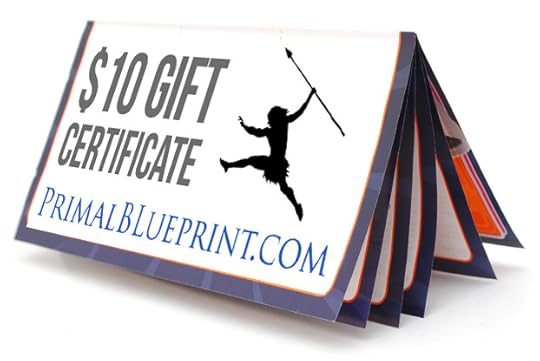 $10 Gift Certificate to PrimalBlueprint.com. Spend it like cash and order whatever you want, perhaps a copy of
The Primal Blueprint
to go with
Death by Food Pyramid
? Or use it to try a Primal Essentials Kit, Primal Fuel or Master Formula on for size!
$10 Gift Certificate to PrimalBlueprint.com. Spend it like cash and order whatever you want, perhaps a copy of
The Primal Blueprint
to go with
Death by Food Pyramid
? Or use it to try a Primal Essentials Kit, Primal Fuel or Master Formula on for size!10% Off Coupon for a Focal Mogo from FocalUprightFurniture.com. A mobile, telescoping stool that’s perfect for switching things up at your standup workstation.
20% Off Coupon from PaleoTreats.com. Yes, there is such a thing as a paleo peanut butter cup.
10% Off Coupon from PrimalPacs.com. Organic, grass-fed, grass-finished beef jerky, dried mango, roasted and salted macadamia nuts, marcona almonds and dried cranberries? Umm… yes please.
25% Off Coupon for a Soft RAD Roller from RadRoller.com. The next best thing to a personal masseuse.
50% Off Coupon for a Vejibag 3-Pack from Vejibag.com. No more slimy vegetables!
20% Off Coupon for Nicks-Sticks.com. Not just any old sticks. Grass-fed beef sticks.
15% Off Coupon for NikkisCoconutButter.com. This stuff is like manna from heaven.
20% Off Coupon for PrimalLifeOrganics.com. Organic, paleo, gluten-free, vegan skincare for 21st century cavemen and women.
2. A personal invite to a private Live Webcast Q&A Session with author Denise Minger.
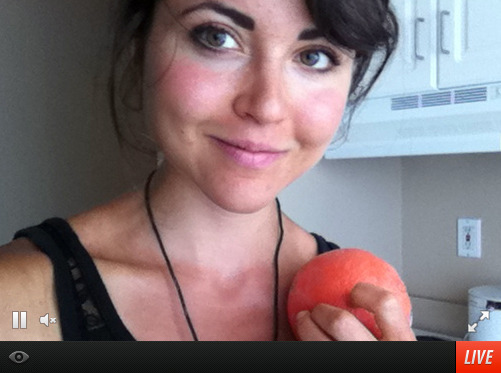 Spend two hours with Denise on Wednesday evening, January 8, from 6:00pm-8:00pm PST for a live Q&A discussion. Ask Denise anything you want via in-browser instant message. She’ll be answering as many questions as she can about the problems in both conventional and “alternative” wisdom, how to individualize your diet for optimal health, and how to understand the scientific findings we hear every day in the news.
Spend two hours with Denise on Wednesday evening, January 8, from 6:00pm-8:00pm PST for a live Q&A discussion. Ask Denise anything you want via in-browser instant message. She’ll be answering as many questions as she can about the problems in both conventional and “alternative” wisdom, how to individualize your diet for optimal health, and how to understand the scientific findings we hear every day in the news.
3. Your name entered to win one of several prizes totaling $1,800 in value:
 One lucky winner will receive a grand prize $1000 gift certificate to Tropical Traditions. Order up to $1000 of grass fed meat, wild Alaskan fish, organic coconut oil, organic dark chocolate, natural skin care products and household cleaners, or anything else from Tropical Tradition’s large range of primal products and get it all for free if your name is selected.
One lucky winner will receive a grand prize $1000 gift certificate to Tropical Traditions. Order up to $1000 of grass fed meat, wild Alaskan fish, organic coconut oil, organic dark chocolate, natural skin care products and household cleaners, or anything else from Tropical Tradition’s large range of primal products and get it all for free if your name is selected.Three lucky runners-up will receive 10 packs of Tendergrass Farms pastured pork franks ($100 value). These are not your average hot dogs. Tendergrass sent me some of these and let me tell you, they are delicious. They’re also sugar-free, nitrite-free, GMO-free, and 100% pastured pork, and only contain these seven ingredients: Pastured Pork, Salt, Coriander, Nutmeg, Garlic, Red Pepper in real pork casings.
Five lucky runners-up will receive a Focal Mogo ($100 value). As I shared in my “How-To: Standup and Mobile Workstations” article, I use a Focal standup workstation at my home office. This is your chance to win a Mogo: a telescoping stool of sorts you can use to take some of the weight off while at your standup desk.
So what are you waiting for? Grab your copy of the riveting new book Death by Food Pyramid for just $24.95 (plus FREE S&H) and claim all of these free gifts today!
Thanks in advance to everyone that orders a copy and participates in this special offer. Grok on!
Fine Print
Unlike previous retail channel promotions, this one is simple: You order the book directly from PrimalBlueprint.com and we send you all the free bonus items. No worries, no hassles!
You will receive an email within an hour of placing your order that will provide you with all of your coupon codes and instructions on how to access the Live Webcast. This email is separate from your email receipt.
This special bonus offer ends at 11:59 pm, Dec. 31, 2013 (PST).
Only orders placed on PrimalBlueprint.com will receive the bonuses.
Death by Food Pyramid is not yet available on Amazon.com or at other retail locations.
Sweepstakes winners will be randomly drawn and announced on Jan. 1, 2014; a great way to start the new year!
Both domestic (U.S.) and international orders are eligible for the bonuses, but keep in mind that only Mogo, Vejibag and Rad Roller ship outside of the United States.
Only domestic orders receive free shipping and handled on Death by Food Pyramid book orders. A handling fee is added to international orders.
All coupons expire on or after Jan. 15, 2014.
The PrimalBlueprint.com gift certificate expires on January 31, 2014, and is valid for a single use.
The “Primal Coupon Book” is not an actual physical coupon book. All coupon codes will be sent to you via email.
Read all sweepstakes fine print here.
Get Your Copy of Death by Food Pyramid Today!

December 10, 2013
12 Holiday Gifts for Your Primal Tribe
 I’d usually make a point to talk about the “true meaning” of Christmas or whatever holiday you’re celebrating in the intro before launching into a huge commercial post about things you should buy this holiday season, but not this time. The following gifts are not pointless consumerist pap that your giftees will enjoy for a day or two until the newness wears off and they move on to the next thing to spend their money on. These are useful gifts. Gifts that enhance life, that further our relationships, that expand our culinary horizons, that compel us to go out and experience the world. There’s no shame in celebrating the holidays in this manner, because these are good gifts given out of love, fellowship, and friendship – all of which embody the true meaning of the season.
I’d usually make a point to talk about the “true meaning” of Christmas or whatever holiday you’re celebrating in the intro before launching into a huge commercial post about things you should buy this holiday season, but not this time. The following gifts are not pointless consumerist pap that your giftees will enjoy for a day or two until the newness wears off and they move on to the next thing to spend their money on. These are useful gifts. Gifts that enhance life, that further our relationships, that expand our culinary horizons, that compel us to go out and experience the world. There’s no shame in celebrating the holidays in this manner, because these are good gifts given out of love, fellowship, and friendship – all of which embody the true meaning of the season.
That said, let’s get to the gifts!
For the Outdoorsman Who Has to Stop Himself From Plunging Face-first Into Streams and Drinking Deeply
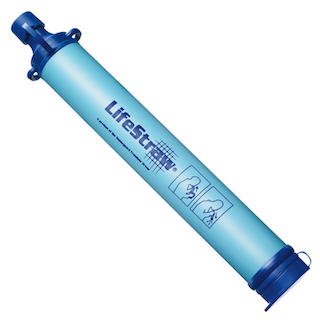 Anytime I’m in the presence of a crystal clear mountain stream, I think about how delicious it must taste. I want to drink from it, and deeply. But I do not, because I likely haven’t the constitution to resist and repel the microorganisms that reside in most every natural source of fresh water. If it were 20,000 years ago, I’d probably be equipped to handle the microbial load. It’s not, so I’m not. Thankfully, a little inexpensive contraption called the LifeStraw Personal Water Filter allows you to drink deeply – about 1000 liters-deep – from fresh water sources. Without using iodine, chlorine, or other disinfectant chemicals, the LifeStraw removes a minimum of 99.999% of waterborne bacteria and a minimum of 99.9% of waterborne protozoan parasites from water. NGOs engaged in humanitarian relief in countries with severely contaminated water use it, so it’s probably pretty effective on your average back country trek through streams that aren’t coursing with human feces. Note: it doesn’t filter out minerals. This can be good, if you’re getting magnesium, calcium, and other trace minerals modern drinking water is largely missing, but it can also be bad if you’re drinking from a stream issuing forth from an abandoned mercury mine.
Anytime I’m in the presence of a crystal clear mountain stream, I think about how delicious it must taste. I want to drink from it, and deeply. But I do not, because I likely haven’t the constitution to resist and repel the microorganisms that reside in most every natural source of fresh water. If it were 20,000 years ago, I’d probably be equipped to handle the microbial load. It’s not, so I’m not. Thankfully, a little inexpensive contraption called the LifeStraw Personal Water Filter allows you to drink deeply – about 1000 liters-deep – from fresh water sources. Without using iodine, chlorine, or other disinfectant chemicals, the LifeStraw removes a minimum of 99.999% of waterborne bacteria and a minimum of 99.9% of waterborne protozoan parasites from water. NGOs engaged in humanitarian relief in countries with severely contaminated water use it, so it’s probably pretty effective on your average back country trek through streams that aren’t coursing with human feces. Note: it doesn’t filter out minerals. This can be good, if you’re getting magnesium, calcium, and other trace minerals modern drinking water is largely missing, but it can also be bad if you’re drinking from a stream issuing forth from an abandoned mercury mine.
For the Primal Chef
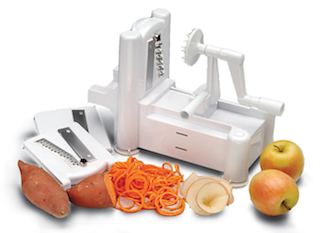 Making Primal-friendly noodles from veggies is hard work. Unless you use the spaghetti squash, which if you bake it right kind of does the work for you. Zucchini, though? Other types of squash? Apples? Sweet potatoes? Carrots? Good luck. You try making noodles from Japanese sweet potatoes with only a knife and I’ll sit back and chuckle in your general direction. If there were a way to make veggie noodles without hours of backbreaking, tedious labor, it would make it way easier to enjoy Primal pasta sauces. Also, kids love things in noodle form; converting vegetables into noodles will help kids eat more vegetables. Anyway, this is a roundabout way of saying that there actually is an affordable, effective kitchen tool for making noodles out of vegetables: the Paderno Spiral Vegetable Slicer.
Making Primal-friendly noodles from veggies is hard work. Unless you use the spaghetti squash, which if you bake it right kind of does the work for you. Zucchini, though? Other types of squash? Apples? Sweet potatoes? Carrots? Good luck. You try making noodles from Japanese sweet potatoes with only a knife and I’ll sit back and chuckle in your general direction. If there were a way to make veggie noodles without hours of backbreaking, tedious labor, it would make it way easier to enjoy Primal pasta sauces. Also, kids love things in noodle form; converting vegetables into noodles will help kids eat more vegetables. Anyway, this is a roundabout way of saying that there actually is an affordable, effective kitchen tool for making noodles out of vegetables: the Paderno Spiral Vegetable Slicer.
For the Outdoorsman Who’s Also a Primal Chef
 Camping and backpacking are great and fun ways to commune with nature and realign yourself and your spirit – but the food’s terrible. People eating a standard American diet don’t find it too off-putting because it means they get to get delicious garbage like cold pop tarts, spam, instant oatmeal, and entire trays of Svenhard’s pastries. We Primals aren’t so lucky. Freeze-dried peas and carrots that you have to reconstitute with water. Endless jerky (I love jerky, but c’mon). Cans of sardines, tuna, and/or salmon (again, I love canned fish, but a man has a breaking point). Forget that. With the BioLite Wood Burning Campstove, a few handfuls of kindling that you found while scrounging around the campsite can heat food, cook real meals, and boil water (or bone broth from the half dozen chipmunks you “found”). It even includes a USB charger that yes, runs on sticks and twigs.
Camping and backpacking are great and fun ways to commune with nature and realign yourself and your spirit – but the food’s terrible. People eating a standard American diet don’t find it too off-putting because it means they get to get delicious garbage like cold pop tarts, spam, instant oatmeal, and entire trays of Svenhard’s pastries. We Primals aren’t so lucky. Freeze-dried peas and carrots that you have to reconstitute with water. Endless jerky (I love jerky, but c’mon). Cans of sardines, tuna, and/or salmon (again, I love canned fish, but a man has a breaking point). Forget that. With the BioLite Wood Burning Campstove, a few handfuls of kindling that you found while scrounging around the campsite can heat food, cook real meals, and boil water (or bone broth from the half dozen chipmunks you “found”). It even includes a USB charger that yes, runs on sticks and twigs.
For the Salad Fan
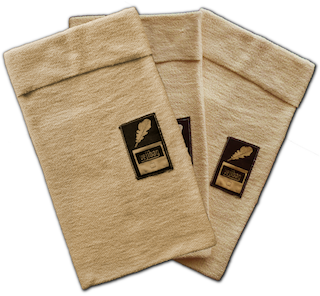 I’m sure we’d all love to be able to pluck fresh greens from our bountiful garden on demand, or walk to the local market for veggies every day around 10 “like they do in Europe.” In reality, most people have to rush over to the market sometime after work, fight crowds, wrestle for the last bag of kale with an older woman with surprisingly strong arms, and buy enough to last the week – because there’s no way we’re gonna make it back anytime soon. That’s a fine solution when you’re buying meat, root vegetables, and other foods that last awhile, but spinach, baby greens, romaine, and other less hearty leafy green vegetables tend to start wilting immediately upon arrival in your fridge. That’s the worst. Nothing worse than some slimy lettuce. The Vejibag, which we use extensively on the Primal Blueprint Luxury Retreats to prevent sliming, is almost magic. You make it a little damp, put just about any vegetable in there – leafy greens, salad makings, broccoli, cabbage, and the list goes on - and the bag will actually make the greens crisper than when they started. An essential tool for any salad fan out there.
I’m sure we’d all love to be able to pluck fresh greens from our bountiful garden on demand, or walk to the local market for veggies every day around 10 “like they do in Europe.” In reality, most people have to rush over to the market sometime after work, fight crowds, wrestle for the last bag of kale with an older woman with surprisingly strong arms, and buy enough to last the week – because there’s no way we’re gonna make it back anytime soon. That’s a fine solution when you’re buying meat, root vegetables, and other foods that last awhile, but spinach, baby greens, romaine, and other less hearty leafy green vegetables tend to start wilting immediately upon arrival in your fridge. That’s the worst. Nothing worse than some slimy lettuce. The Vejibag, which we use extensively on the Primal Blueprint Luxury Retreats to prevent sliming, is almost magic. You make it a little damp, put just about any vegetable in there – leafy greens, salad makings, broccoli, cabbage, and the list goes on - and the bag will actually make the greens crisper than when they started. An essential tool for any salad fan out there.
For the Shoe Addict
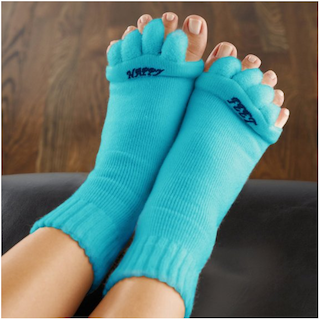 It’s often not enough for chronic shoe wearers to go barefoot some of the time. If they keep their toes shoved into a tiny space fit for two, maybe three toes max during normal office hours, simply removing the shoes won’t restore the ancestral toe environment. You need to fight back. In order to counteract the toe compression, your toes require active expansion. You could fill the spaces between your toes with tightly packed cotton balls or rolled up documents, or you could wear Happy Feet Foot Alignment Socks. Foot Alignment Socks have built-in toe dividers that “reverse the effect of wearing narrow shoes.” If you or someone you know has feet like look like the “before” picture in this post, Happy Feet Foot Alignment Socks might make the feet happy.
It’s often not enough for chronic shoe wearers to go barefoot some of the time. If they keep their toes shoved into a tiny space fit for two, maybe three toes max during normal office hours, simply removing the shoes won’t restore the ancestral toe environment. You need to fight back. In order to counteract the toe compression, your toes require active expansion. You could fill the spaces between your toes with tightly packed cotton balls or rolled up documents, or you could wear Happy Feet Foot Alignment Socks. Foot Alignment Socks have built-in toe dividers that “reverse the effect of wearing narrow shoes.” If you or someone you know has feet like look like the “before” picture in this post, Happy Feet Foot Alignment Socks might make the feet happy.
For the Little One
 I’m going to be a bit contrarian and maybe a little cheesy here and suggest that the most Primal gift you can give your kid (or nephew/niece, whatever the relationship may be) is your attention. Your immediate, full, undivided, unadulterated attention. Be present when you’re with them. This kid is going to get some tangible presents regardless, maybe even from you, so the Primal “non-gift” of simply being there with them in the moment(s) will be appreciated. Read a book. Throw a ball. Roughhouse. Go outside and dig around in the garden or the woods for bugs (heck, if you want to give a cool tangible gift, try a bug collecting kit!). Tell jokes. Watch A Christmas Story. Enjoy your time together.
I’m going to be a bit contrarian and maybe a little cheesy here and suggest that the most Primal gift you can give your kid (or nephew/niece, whatever the relationship may be) is your attention. Your immediate, full, undivided, unadulterated attention. Be present when you’re with them. This kid is going to get some tangible presents regardless, maybe even from you, so the Primal “non-gift” of simply being there with them in the moment(s) will be appreciated. Read a book. Throw a ball. Roughhouse. Go outside and dig around in the garden or the woods for bugs (heck, if you want to give a cool tangible gift, try a bug collecting kit!). Tell jokes. Watch A Christmas Story. Enjoy your time together.
For the Laptop Jockey Who Understands the Dangers of Sitting but Doesn’t Want to Stand All Day
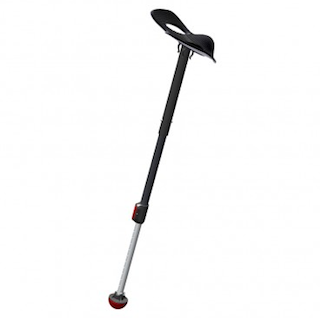 You might recall my “leaning workstation” as seen in the How-to: Standup and Mobile Workstations video from a couple months ago, the Locus Seat from Focal. It’s sort of a human kickstand that allows me to alternate between leaning and standing. Leaning is kind of like sitting in that it takes the load off, just without shortening your hip flexors and turning your glutes into a amorphous gelatinous blobs. I love it. If you liked the look of it and want something similar, might I suggest the Mogo? It’s also made by Focal, and it’s of a similar design and also allows you to lean and stand, but it’s less expensive and more mobile, weighing just over 2 pounds and collapsing for easy storage. That means you can take it along with you to the office, the cafe, the great outdoors (laptop on a stump, anyone?), or when you travel, and get strange looks and lots of questions while you get work done.
You might recall my “leaning workstation” as seen in the How-to: Standup and Mobile Workstations video from a couple months ago, the Locus Seat from Focal. It’s sort of a human kickstand that allows me to alternate between leaning and standing. Leaning is kind of like sitting in that it takes the load off, just without shortening your hip flexors and turning your glutes into a amorphous gelatinous blobs. I love it. If you liked the look of it and want something similar, might I suggest the Mogo? It’s also made by Focal, and it’s of a similar design and also allows you to lean and stand, but it’s less expensive and more mobile, weighing just over 2 pounds and collapsing for easy storage. That means you can take it along with you to the office, the cafe, the great outdoors (laptop on a stump, anyone?), or when you travel, and get strange looks and lots of questions while you get work done.
For the Workaholic
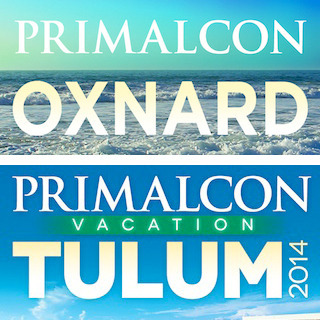 Time off from active, engaged work is essential for a happy, healthy human being. There is simply no getting around that fact. If you know a workaholic – and modern America is rife with them – you know someone that needs a vacation. But not just any vacation. Weekend getaways up the coast and cute bed and breakfasts won’t cut it. For true workaholics putting in fifty, sixty hour weeks, checking email on the weekends and in bed, and never quite able to engage with actual, everyday life because his or her head’s always got one foot in the office, hardcore vacation is required. Next March, in Tulum, Mexico, we’ll be holding a fantastic, all-inclusive PrimalCon at one of Mexico’s premier resorts. Join me, Robb Wolf, and assorted Primal health and fitness experts for the vacation of a lifetime! Or, if Tulum’s not quite your bag, check out the fifth annual PrimalCon Oxnard in late September. Sun, fun, sand, and your Primal tribe. Only downside is you won’t get to practice your Spanish in Oxnard.
Time off from active, engaged work is essential for a happy, healthy human being. There is simply no getting around that fact. If you know a workaholic – and modern America is rife with them – you know someone that needs a vacation. But not just any vacation. Weekend getaways up the coast and cute bed and breakfasts won’t cut it. For true workaholics putting in fifty, sixty hour weeks, checking email on the weekends and in bed, and never quite able to engage with actual, everyday life because his or her head’s always got one foot in the office, hardcore vacation is required. Next March, in Tulum, Mexico, we’ll be holding a fantastic, all-inclusive PrimalCon at one of Mexico’s premier resorts. Join me, Robb Wolf, and assorted Primal health and fitness experts for the vacation of a lifetime! Or, if Tulum’s not quite your bag, check out the fifth annual PrimalCon Oxnard in late September. Sun, fun, sand, and your Primal tribe. Only downside is you won’t get to practice your Spanish in Oxnard.
For the Sleep Deprived
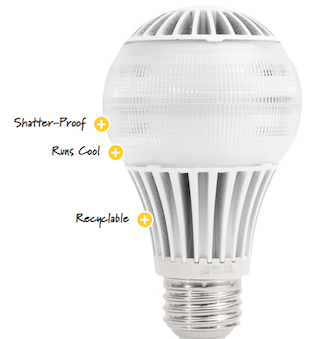 We all know how much blue light (from LED screens, light bulbs, electronic devices, and the atmosphere) can interfere with normal melatonin production and keep us from falling asleep. Proper sleep and normal circadian rhythm is vital for health and wellness. NASA knows too, which is why they asked a company called Definity Digital to design an LED bulb that removes most of blue light and allows melatonin to be released. The coolest part of all is that the light still looks white, so you can read, cook, and do just about anything else that requires adequate lighting without negatively impacting your circadian rhythm. Win win. The light is called Good Night, fits standard sockets, lasts longer than most other bulbs, and works with dimmers.
We all know how much blue light (from LED screens, light bulbs, electronic devices, and the atmosphere) can interfere with normal melatonin production and keep us from falling asleep. Proper sleep and normal circadian rhythm is vital for health and wellness. NASA knows too, which is why they asked a company called Definity Digital to design an LED bulb that removes most of blue light and allows melatonin to be released. The coolest part of all is that the light still looks white, so you can read, cook, and do just about anything else that requires adequate lighting without negatively impacting your circadian rhythm. Win win. The light is called Good Night, fits standard sockets, lasts longer than most other bulbs, and works with dimmers.
For the Coffee Addict
 Let me get this off my chest: there is nothing wrong, and many things right, with coffee. I drink it myself, daily. But addiction is a bad thing, and when you’re measuring your coffee intake in pots, when you get a headache from even thinking about decaf, you’re probably addicted and you may want to reduce your intake of coffee. Luckily, there are other ways to increase focus, attention, mental acuity, and boost productivity. No, not methamphetamine. Blue light. As I wrote about a few weeks ago, blue light has been shown to increase wakefulness and boost cognitive function. It doesn’t even have to replace coffee; blue light and coffee are actually quite synergistic. That’s why I’ve chosen the Syrcadian Blue SB-1000 SAD Light Therapy device, which can be used against seasonal affective disorder or as a cognitive enhancer. You can even attach it to your car and get your dose of blue light on the morning commute.
Let me get this off my chest: there is nothing wrong, and many things right, with coffee. I drink it myself, daily. But addiction is a bad thing, and when you’re measuring your coffee intake in pots, when you get a headache from even thinking about decaf, you’re probably addicted and you may want to reduce your intake of coffee. Luckily, there are other ways to increase focus, attention, mental acuity, and boost productivity. No, not methamphetamine. Blue light. As I wrote about a few weeks ago, blue light has been shown to increase wakefulness and boost cognitive function. It doesn’t even have to replace coffee; blue light and coffee are actually quite synergistic. That’s why I’ve chosen the Syrcadian Blue SB-1000 SAD Light Therapy device, which can be used against seasonal affective disorder or as a cognitive enhancer. You can even attach it to your car and get your dose of blue light on the morning commute.
For the Brown Bagger
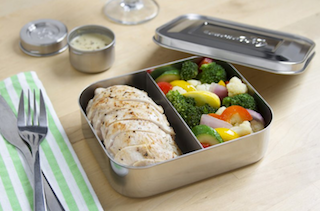 The one major downside of going Primal is that packing your lunch for work or school can be an ordeal. It takes planning and special containers. You can’t just fill a sandwich bag with pot roast, or slop some of your homemade coconut soup into a lunchbox. No, your leftovers are often saucy, drippy, and require structure and a seal that won’t fail. You could go the glass tupperware route, but glass is heavy. Plastic solves that problem, but introduces potentially estrogenic compounds to your food. Enter LunchBots - a line of stainless steel receptacles for your food. Depending on which model you want, LunchBots can protect the structure of your lunch, keeps it from leaking out, keep food hot or cold, and is totally non-reactive. No plastic compounds, no BPA, no weird metallic or plastic-y taste worming its way into your meal.
The one major downside of going Primal is that packing your lunch for work or school can be an ordeal. It takes planning and special containers. You can’t just fill a sandwich bag with pot roast, or slop some of your homemade coconut soup into a lunchbox. No, your leftovers are often saucy, drippy, and require structure and a seal that won’t fail. You could go the glass tupperware route, but glass is heavy. Plastic solves that problem, but introduces potentially estrogenic compounds to your food. Enter LunchBots - a line of stainless steel receptacles for your food. Depending on which model you want, LunchBots can protect the structure of your lunch, keeps it from leaking out, keep food hot or cold, and is totally non-reactive. No plastic compounds, no BPA, no weird metallic or plastic-y taste worming its way into your meal.
For Anyone
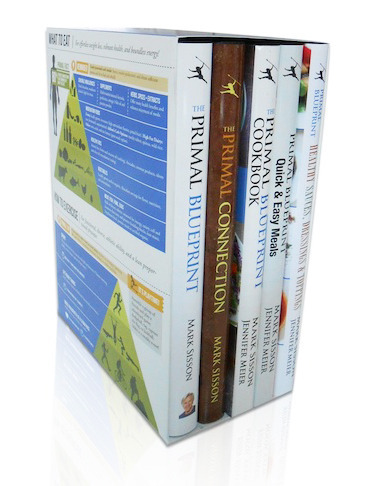 For everyone and anyone else, we’ve got the perfect compendium of all the most important Primal literature, including The Primal Blueprint, The Primal Connection, The Primal Blueprint Cookbook, The Primal Blueprint Quick & Easy Meals, and Primal Blueprint Healthy Sauces, Dressings & Toppings. With The Primal Blueprint Box Set, you get everything you or a loved one needs to get up to speed on all things Primal. Order a box set by Dec. 18 and you’ll save 20% off the retail price, and get free apparel, a free poster, a free shopping list and pen, and free Grok decal as detailed in this post.
For everyone and anyone else, we’ve got the perfect compendium of all the most important Primal literature, including The Primal Blueprint, The Primal Connection, The Primal Blueprint Cookbook, The Primal Blueprint Quick & Easy Meals, and Primal Blueprint Healthy Sauces, Dressings & Toppings. With The Primal Blueprint Box Set, you get everything you or a loved one needs to get up to speed on all things Primal. Order a box set by Dec. 18 and you’ll save 20% off the retail price, and get free apparel, a free poster, a free shopping list and pen, and free Grok decal as detailed in this post.
And tomorrow, Denise Minger’s long-awaited book Death by Food Pyramid will be released. It makes a great gift, so be sure to check back tomorrow to pick up a copy or two and get some free goodies, including discount coupon codes for the Vejibag and Mogo gifts described above!
Looking for more gift ideas? I’ve been doing these posts on an annual basis, so check out these for even more primal present inspiration:
10 Last-Minute Primal Gift Ideas (2012)
10 Holiday Gifts for Your Primal Tribe (2011)
13 Holiday Gifts to Support a Primal Lifestyle (2010)
Primal Holiday Gifts (2009)
What about you, folks? What Primal gifts are you currently coveting? What are you giving out this year? Let us know in the comment section!
The Perfect Holiday Gift, The Primal Blueprint Box Set Is Now Available! Get FREE Apparel and Grok Decal with Purchase Through Dec. 18. Learn All the Details Here.

December 9, 2013
Dear Mark: Full-Fat Dairy Roundup
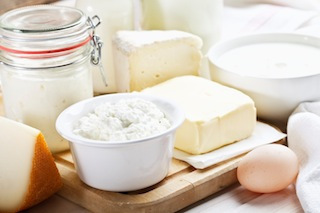 Last week, I wrote about how the available evidence indicates that full-fat dairy is a very healthy, nutritious source of food for people who tolerate it. The comment section exploded with questions, so I figured I’d use this week’s “Dear Mark” to answer most of them. First up is a question about dairy’s oft-reported positive effect on weight gain. Next, I briefly go over the A1/A2 milk issue. Is it something you actually have to worry about? (Maybe.) After that, I discuss whether dairy has to be raw to be worth eating (or drinking), and I give my rationale for choosing the dairy that I do. Then I give my take on why the osteoporosis rates in the United States are high despite our high dairy consumption, followed by whether using inflammatory forms of dairy to heighten the post-workout spike in inflammatory markers makes sense. And finally, does a gluten intolerance make dairy more problematic?
Last week, I wrote about how the available evidence indicates that full-fat dairy is a very healthy, nutritious source of food for people who tolerate it. The comment section exploded with questions, so I figured I’d use this week’s “Dear Mark” to answer most of them. First up is a question about dairy’s oft-reported positive effect on weight gain. Next, I briefly go over the A1/A2 milk issue. Is it something you actually have to worry about? (Maybe.) After that, I discuss whether dairy has to be raw to be worth eating (or drinking), and I give my rationale for choosing the dairy that I do. Then I give my take on why the osteoporosis rates in the United States are high despite our high dairy consumption, followed by whether using inflammatory forms of dairy to heighten the post-workout spike in inflammatory markers makes sense. And finally, does a gluten intolerance make dairy more problematic?
Let’s go:
I do wonder, though, why dairy is often implicated in weight gain (or weight loss stalls). Is it simply a matter of a calorically dense food that is easy to overeat? Or is there something else going on?
There seems to be conflicting evidence, doesn’t there? On the one hand, the bulk of available studies suggest an inverse association between dairy intake and weight gain – people who eat the most dairy, whether it’s cheese, milk, butter, or yogurt, seem to lose the most or gain the least weight.
Yet anecdotal reports often contradict the published research. They don’t pass peer review, but we can’t discount them entirely. Not everyone is lying or deluded about their experiences, believe it or not.
One explanation: it’s individual. Some people gain weight on dairy, some people lose it, some people remain at the same weight, and this can be reflected in the studies. Even if a few participants gained weight in one trial, the overall trend could be weight loss or stasis if the mean (average) effect on weight was neutral or negative. Outliers always exist. In fact, we’re generally all outliers from each other.
Another explanation: weight gained from dairy is both lean and fat – bones, muscle, and, yeah, maybe some adipose tissue. The scale never tells the entire story.
Yet another: dairy is calorically-dense, delicious, and easy for some to overeat. Particularly if you’re talking liquid dairy. Anytime you’re consuming caloric liquids, you run the risk of overdoing it. Chugging a big glass of milk might be the quickest way to eat a bunch of food at once.
Still another: among the Primal/ancestral/paleo community, dairy is a frequent topic of discussion and experimentation. People are constantly wondering about dairy’s place in their diet and “throwing it in” to see “how it affects them.” They’re adding whole milk to their post-workout meal. Incorporating a snack of aged cheese. Adding a cup of yogurt to their berries. In most cases, people are adding dairy to their diet without removing anything. They’re increasing their overall food intake. This can increase body weight.
What do you think about A1 versus A2 milk?
There’s a lot of literature to sift through, including an entire book (Devil in the Milk), so I’ll try to summarize my big takeaway.
A1 and A2 refer to two types of beta-casein (a protein) found in milk. A1 milk has mostly A1 beta-casein and A2 milk has mostly A2 beta-casein. Essentially all mammalian milk studied has beta-casein, but only certain (“newer”) breeds of cattle, like Holsteins, make significant amounts of A1 beta-casein. Goats, sheep, humans, and some other (“older”) breeds of cattle like Jerseys mostly produce A2 beta-casein. Why might this matter? What exactly is the issue?
When A1 beta-casein is digested, one of the byproducts is beta-casomorphin-7 (BCM7). BCM7 is a peptide that acts a bit like an opioid (hence “morphin”), and if it can resist complete digestion and get through the gut lining into the bloodstream, BCM7 seems to cause problems. Keith Woodford (author of Devil in the Milk) lays out the issues in a 2011 paper here (PDF).
But it sounds like intestinal permeability, or leaky gut, is a prerequisite for damage to occur.
For the first six or so months of their lives, infants have a leaky gut by design. It allows the passage of larger, beneficial protein fragments, like from their mother’s colostrum, into the bloodstream. In infants fed formula made with A1 cow milk (which is most of them), a baby’s leaky gut also allows BCM7 into the bloodstream. A study found that formula-fed infants showed elevated serum levels of bovine BCM7, especially among subjects with a genetic defect in the enzyme that breaks down BCM7. This effect was most pronounced during the first 3 months, when the gut is leakiest. High levels of bovine BCM7 were also correlated with delayed psychomotor development. The breastfed group also had BCM7 in the blood, but human BCM7; this was correlated with normal psychomotor development.
The purported links between A1 milk consumption and type 1 diabetes also appear to be mediated by the age of consumption (and thus leaky gut). A1 milk during the first two years (when the gut tends to be leakier) of life was associated with type 1 diabetes, while A1 milk consumption during the early adolescent years (when the gut tends to be less permeable) was not.
So, is it a problem? I’m not sure. Maybe for infants, although BCM7 in the blood may simply be a marker of formula feeding (which we already know to be inferior to breastfeeding). Maybe for people with leaky gut. However, I question whether A1 BCM7 makes it through intact, adult (or even teenage) gut linings. If A1 milk is a problem, I think it probably depends on your gut health – like so many other things.
Here in northern Canada, we can only get organic full fat pasteurized dairy products. I would really like to know if there is any benefit to eating them when they are all pasteurized? Or are the benefits completely mitigated by the pasteurization process…I realize it is better to have raw…just not available here….
Applying a firm latch directly to the animal’s protruding, leaking teat with your mouth is the surest way to get untouched, pure, unprocessed dairy, but that’s the ideal (well, something like the ideal) that few of us will ever attain.
Here’s how it works out for me. My butter is mostly grass-fed, but not organic. My yogurt is organic and pasture-fed, but not completely grass-fed. My Greek yogurt is conventional and presumably not pasture-fed. My cream is pasture-fed and organic, but not fully grass-fed. My cheese is sometimes raw and grass-fed, sometimes just grass-fed, and sometimes neither; it’s rarely organic. So it’s not a nice linear continuum with raw at the desired beginning. I make choices based on what’s available and what dairy food I’m actually buying. I’m not wedded to any single label.
I don’t stress too hard about raw dairy because I’m not drinking fluid milk. Raw milk is where most of the benefits appear. Raw whey, for example, is pretty good at boosting glutathione status when you eat it.
Instead, I go for fermented dairy – cheese, yogurt, the occasional batch of kefir – and dairy fat – cream and butter. With those foods, the raw aspect, while a nice bonus, isn’t all that crucial. That they are grass-fed or pasture-fed is probably the most important factor I’m looking for. Plus, remember tbe vast majority of those studies I mentioned last week linking full-fat dairy to various health benefits were referring to pasteurized, standard dairy, not raw dairy. Raw dairy likely isn’t necessary to get the benefits, at least not all of them.
Can you discuss the possible relation between dairy products and metabolic bone disease? As you know, the USA consumes more dairy products than any in the world, and yet have the highest incidence of Osteoarthritis.
Actually, the US ranks 16th in dairy consumption per capita, well behind most Northern European and some Eurasian countries. Furthermore, while Nordic countries like Sweden and Finland get most of their dairy from milk, and Greece and Switzerland get most of theirs from cheese, the dairy situation in the United States is a little different.
We’re drinking less milk than ever.
We eat the most ice cream in the world (as of 2011, at least). There are very few bone-building nutrients in ice cream.
We’re eating less butter and more “butter.” And the butter we do eat tends to be the alabaster, factory-farmed variety low in bone-supportive vitamin K2.
But your overall point that we eat a lot of dairy and still have poor bone health is sound, and this is simply evidence that calcium is not enough to ensure good bone density. Vitamin D status, vitamin K2 intake, even the amount of protein you eat impact the health of your skeletal system. Lifting weights and just staying active enough and moving your body against gravity on a regular basis improve bone density. Sitting around on cushioned sofas using only enough musculature to follow the screen with your eyes and cram chips into your mouth provides insufficient stimulus for maintenance of bone density. You aren’t working against gravity. Gravity is at least acting upon you (can’t say the same for astronauts in space who end up losing tons of bone and muscle), but you aren’t acting back.
Post workout, you want inflammation to be high, because the higher the inflammation, the stronger the recovery (I learned this from you, Mark). Low-fat dairy = inflammation and insulin spike, and protein. So non-fat greek yogurt post workout = best PWO snack ever?
Interesting way of thinking! I see where you’re coming from, but I don’t think heaping even more inflammation (from dietary input, no less) on top of the inflammation created by an effective training session will help. All the inflammation you need should and will come from the actual training. It’s not that “inflammation is good post-workout.” It’s that “training-induced inflammation is necessary for the training effect.” It’s a balance. Upsetting that balance in either direction could impair the results you’re expecting.
Insulin spike, post-workout? Sure, that’s helpful for shuttling in nutrients, particularly if you’re looking to increase muscle mass and restore glycogen levels as quickly as possible. The low-fat Greek yogurt might be “better,” but not because it’s increasing inflammation above and beyond what you’re already get from the workout.
I have heard that if you are gluten intolerant you should leave milk alone also. Is this true?
If your gluten intolerance is accompanied by elevated intestinal permeability (or “leaky gut”), you might want to try a period of dairy avoidance. A leaky gut can allow partially digested proteins from the food you eat pass into your bloodstream where your immune system reacts, and dairy contains potentially reactive proteins (especially casein and related byproducts like the aforementioned BCM7).
Though the evidence isn’t totally clear, gluten may increase intestinal permeability in everyone, celiac, gluten sensitive, and non-gluten sensitive alike by stimulating the release of zonulin, the compound that toggles intestinal permeability. It’s not a problem for everyone, because their immune systems can take care of any invading proteins without it developing into an inflammatory issue or an autoimmune attack on their own cells.
Try dairy. Just be careful with it. And don’t eat dairy if you’ve been eating gluten recently, especially if you’ve got a confirmed sensitivity to gluten.
That’s it for today, folks. Thanks for reading – and asking! Let me know if you have any other dairy-related questions.
The Perfect Holiday Gift, The Primal Blueprint Box Set Is Now Available! Get FREE Apparel and Grok Decal with Purchase Through Dec. 18. Learn All the Details Here.

December 8, 2013
Weekend Link Love
 People of Newark, Delaware, and Philadelphia, Pennsylvania: we’ve got Primal Blueprint seminars coming your way on February 27, and March 20, 2014, respectively. Come join us!
People of Newark, Delaware, and Philadelphia, Pennsylvania: we’ve got Primal Blueprint seminars coming your way on February 27, and March 20, 2014, respectively. Come join us!
Research of the Week
After they suffer a spinal cord injury, ketogenic dieting helps mice regain forelimb motor function.
It’s looking like the “obese or overweight but metabolically healthy” human isn’t actually all that healthy.
How exercise and physical movement – even just walking – promotes creativity.
Interesting Blog Posts
Poop pills are a thing, and they might replace fecal transplants (which, yes, are also a thing).
“Forest kindergarten” is exactly what it sounds like.
Media, Schmedia
Is it really possible to waste time, or is it all just a state of mind (and misplaced priorities)?
If we think we’re drinking “eco-friendly” coffee, it tastes better.
Everything Else
Neanderthals: apex predators, skilled craftsmen, neat freaks?
Check out this great review for The Hidden Plague over at PaleoNonPaleo.
Babies have an innate mistrust of all plants, probably an evolutionary defense mechanism that arose because it’s difficult to tell which ones are obviously toxic.
If you can’t (or won’t) squat to poop, this toilet might be the next best thing.
I’m not quite sure if this guy was lucky or unlucky.
Recipe Corner
It’s a crispy, briny, fatty celebration of pork flesh, a porcine supernova, a roast hunk of mammal that you can cut with a fork: porchetta.
Head on down to the local grocer who’s trying to figure out what to do with all the delicata squash he bought for Thanksgiving and make some baked delicata moons.
Time Capsule
One year ago (Dec 8 – Dec 14)
7 Foods You Don’t Need to Buy Organic – Organic is generally the better choice, but it’s not always the economical one. Here are seven foods you can happily enjoy conventionally.
Dear Mark: Food Fatigue Edition – I answer a bunch of questions from people who are sick of otherwise tasty, healthy, nutrient-dense Primal foods.
Comment of the Week
Tell it to the Masai.
- Gayle
The Perfect Holiday Gift, The Primal Blueprint Box Set Is Now Available! Get FREE Apparel and Grok Decal with Purchase Through Dec. 18. Learn All the Details Here.

December 7, 2013
Lamb and Prune Tagine
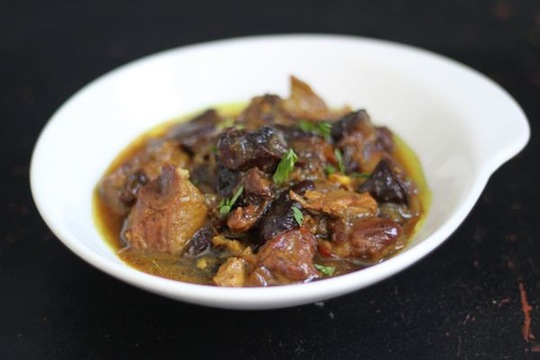 The name of this recipe doesn’t really do the dish justice. Prunes just aren’t sexy ingredients, even if you call them dried plums. But the way they meld with lamb, creating a perfect sweet and savory flavor, is nothing short of transcendent.
The name of this recipe doesn’t really do the dish justice. Prunes just aren’t sexy ingredients, even if you call them dried plums. But the way they meld with lamb, creating a perfect sweet and savory flavor, is nothing short of transcendent.
Every bite combines a meaty, tender morsel of lamb with a hint of sweet, soft prune. Saffron, turmeric, ginger, garlic and onion add layers of warm, complex flavor. This is a simple throw-it-in-the-pot-and-let-it-simmer kind of meal that’s dinner party and holiday worthy.
The ingredients in this tagine were chosen because they taste incredible together, but as a bonus they offer plenty of health benefits too. Turmeric is a promising weapon against inflammation, cancer and dementia. Ginger is a digestive aid, and onions and garlic add to your intake of sulfur-rich vegetables. Lamb is a great source of B vitamins, niacin and zinc and prunes have a decent amount of antioxidants. Prunes fall into the “sensible indulgences” category, but if you want to add even fewer prunes than the recipes calls for, go ahead. The dish will still taste great.
But don’t obsess about all those health benefits while you’re eating. Just enjoy the unique and complex flavors of a comforting and delicious meal. And pray that you have leftovers, because this lamb and prune tagine tastes just as good (if not better) the next day.
Servings: 4 to 6
Time in the Kitchen: 3 hours
Ingredients:

3 tablespoons coconut oil (45 ml)
2 onions, finely chopped
3 garlic cloves, finely chopped or pressed
1-inch (2.5 cm) piece of gingerroot, peeled and thinly sliced or finely chopped
1/2 teaspoon turmeric (2.5 ml)
1/2 teaspoon saffron threads, crumbled (2.5 ml)
2 1/2 pounds lamb shoulder, cut into 3-inch cubes and seasoned with salt and pepper (1.13 kg)
1 cinnamon stick
1 cup pitted prunes, halved (140 g)
Instructions:
Heat the coconut oil over medium heat in a wide, deep pot or saucepan. Add the onion, garlic, ginger and turmeric. Sauté 3 to 5 minutes.
Add the saffron and lamb and saute a few minutes more to lightly brown the meat. Add the cinnamon stick and just enough water to cover the meat, about 3 cups.
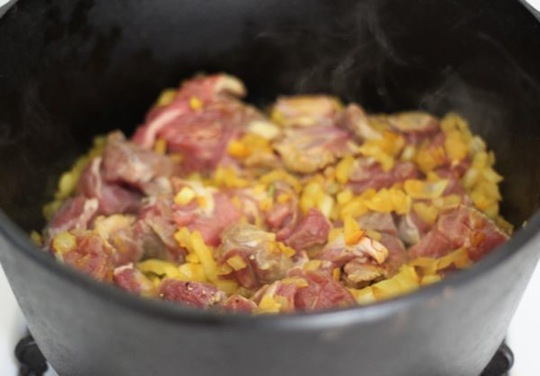
Bring the water to a boil then cover the pot and reduce the heat to a simmer. Simmer gently until the lamb is very tender, about 1 1/2 to 2 hours. If necessary, add more water as the lamb cooks to keep the top of the meat from peaking out of the water and drying out.

Remove the cinnamon stick. If desired, skim excess oil off the top. Add the prunes and a sprinkle of sea salt and a few grinds of black pepper. Keep the lid off the pot and simmer 20 to 30 minutes more, reducing the liquid and softening the prunes.

Not Sure What to Eat? Get the Primal Blueprint Meal Plan for Shopping Lists and Recipes Delivered Directly to Your Inbox Each Week

December 6, 2013
Healthier at Age 44 Than 24: How I Lost 115 Pounds and Turned My Life Around
It’s Friday, everyone! And that means another Primal Blueprint Real Life Story from a Mark’s Daily Apple reader. If you have your own success story and would like to share it with me and the Mark’s Daily Apple community please contact me here. I’ll continue to publish these each Friday as long as they keep coming in. Thank you for reading!
 Dear Mark,
Dear Mark,
I am 44 years old. I am a critical care clinical pharmacist. It is my job to follow current medical guidelines in regard to providing ~30% protein – 30% fat – 40% carbohydrate intravenous nutrition to patients and modulating macro and micronutrients based on their respective clinical situation. For over 20 years I have been well aware of the exact macronutrient composition of what I was personally “supposed” to be taking in, and exactly what I was actually taking in…down to the gram. During my 30s, I was extremely frustrated that I couldn’t ever figure out why I ate what I ate.
All my life I was a big eater, I loved all foods. I had a significant sweet tooth and it was clear that I enjoyed chocolate and desserts much more than the average person. I am 5’11”. I was about 185 pounds in high school. As a teenager I was never considered thin, but I had very fast sprint times, I played most high school varsity sports, I played club baseball in college, and walked on our Division One golf team (and they let me stay).
In my first two years of college my weight went up to the 230 pound range. I was able to get back down around 200 pounds my third year by becoming a gym rat – intense weightlifting and StairMaster most days of the week. My weight cycled again after college and I was able to drop the weight by spending a lot of time in the gym and racquetball court, and I also did a lot of mountain and road biking. I also followed the conventional wisdom and did a great job at eating a low-fat diet.
I worked a few years in community pharmacy, and in hospital pharmacy for four years. In 1996 I went back to grad school two years, maintained a half-time job, spent a lot of time exercising, and a lot of time eating out. During those busy, fun years, I didn’t sleep much and I was able to maintain fairly good fitness from a strength and cardio perspective; my waist size was 36 or 38 depending on the clothing brand or style.
A few weeks after grad school and we were married, my wife started an intense post grad pharmacist residency while I worked full time. We lived in a wonderful resort community and really only had time to work long hours and experience all the great restaurants. Exercise basically stopped that year and my waist size quickly went up to 42 inches. A year later we moved to Houston, Texas for my critical care residency – again, long work hours and an abundance of fantastic food, little to no exercise and little sleep yielded a 46 inch waist in my early 30s and my weight fluctuated from 240 to 280 for the next ten years. My energy levels fluctuated severely. Sporadic dieting and exercise would bring it down a few months here and there. I never looked into Atkins since it was high fat. I never consistently stuck to one diet or exercise regimen – all I was certain about was that whenever I craved a specific food, whether it be a cheeseburger, crème brûlée or lasagna – my mind fixated on it until I ate it. More was better – like I was always hungry, even though my stomach was full. Restricting foods or calories in general left me in a state of craving that could only be satisfied with eating the food I craved, albeit temporarily. This was more and more frustrating, and scary, as my health was seemingly slipping away…I would frequently discuss with my wife that the only way for me to drop 50 pounds was to drastically cut my caloric intake for years and start training for a marathon, which seem insurmountable. In 2009 and 2010 my weight went over the limit of most scales – I estimate that I was well over 320 pounds – my Levi’s jeans waist size was 50 inches and my shirts were size 22 neck or XXXL; depending on the brand or style, most were uncomfortably tight. Despite the lack of formal exercise, I maintained decent strength with frequent yard work or unusual projects lifting heavy things. It was hard work, but I was able to enjoy my stand up jet-ski each summer, even though it was not made for a guy my size.
few weeks after grad school and we were married, my wife started an intense post grad pharmacist residency while I worked full time. We lived in a wonderful resort community and really only had time to work long hours and experience all the great restaurants. Exercise basically stopped that year and my waist size quickly went up to 42 inches. A year later we moved to Houston, Texas for my critical care residency – again, long work hours and an abundance of fantastic food, little to no exercise and little sleep yielded a 46 inch waist in my early 30s and my weight fluctuated from 240 to 280 for the next ten years. My energy levels fluctuated severely. Sporadic dieting and exercise would bring it down a few months here and there. I never looked into Atkins since it was high fat. I never consistently stuck to one diet or exercise regimen – all I was certain about was that whenever I craved a specific food, whether it be a cheeseburger, crème brûlée or lasagna – my mind fixated on it until I ate it. More was better – like I was always hungry, even though my stomach was full. Restricting foods or calories in general left me in a state of craving that could only be satisfied with eating the food I craved, albeit temporarily. This was more and more frustrating, and scary, as my health was seemingly slipping away…I would frequently discuss with my wife that the only way for me to drop 50 pounds was to drastically cut my caloric intake for years and start training for a marathon, which seem insurmountable. In 2009 and 2010 my weight went over the limit of most scales – I estimate that I was well over 320 pounds – my Levi’s jeans waist size was 50 inches and my shirts were size 22 neck or XXXL; depending on the brand or style, most were uncomfortably tight. Despite the lack of formal exercise, I maintained decent strength with frequent yard work or unusual projects lifting heavy things. It was hard work, but I was able to enjoy my stand up jet-ski each summer, even though it was not made for a guy my size.
My health the past 13 years has been a roller coaster ride. I had hyperlipidemia, elevated liver enzymes, several sebaceous cysts surgically removed, extremely severe acne (dermatologist treated 30 years), GERD, irritable bowel, and frequent strep throat. I had several extreme febrile episodes of unknown diagnosis. I did have viral meningitis in 2007 and then significant migraines followed monthly for years. I had the best health care experts in the world review my issues. Luckily, nothing ominous was ever found. The migraines and febrile episodes waxed and waned. I learned to get used to it. I frequently felt fatigued and just wanted to collapse when home from work; I had poor sleep for many years – I attributed it to being 40 and overweight. I also had significant joint pain and stiffness in my shoulders, neck, ankles and knees – again I attributed it to getting older, being overweight and past injuries.


I tried many different approaches to weight loss and maintaining exercise and became more perplexed and frustrated when it didn’t work or my interventions made me feel worse. In September of 2011 Gary Taubes came and spoke at my workplace. Had Gary not come to present his book I probably would never consider low carb diets or read his books – after the talk; however, I immediately read his books. I was sold on trying low carb when I learned of the Banting Diet – I could still have red wine! Plus, I thought it would fail either from a disease reason or lack of weight loss – like the dozens of other diets that “failed” me. I discussed with my fantastic family physician and he mentioned he had several patients do well on low carb diets. He said he would check my labs every four months while I experimented with a low carb, high protein, high fat diet.
By November 2011 I was maintaining ketosis and enjoying it. I followed the Atkins Induction Phase recommendations strictly and scoured the web for other ideas. Whenever I craved something I immediately ate meat, cheese or salad – I seemingly was ingesting something hourly the first few weeks – most days I had several thousand total calories, I enjoyed steaks, chicken wings and salads with full-fat dressings. I came across marksdailyapple.com when researching low carb options. Since then it has become one of my mainstays of nutrition, exercise and overall well-being.


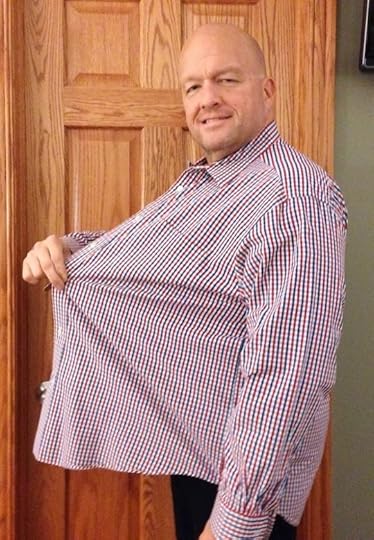
My energy, sleep quality, every aspect of my health and day to day feeling, is as good or better now at age 44 as it was when I was 24. Everything…yes, EVERYTHING – and now I am spending 80% less time “exercising”.
When others ask me, these are my highlights of why I will continue a Primal, nutritional ketosis lifestyle, and why I recommend others try it:
Incredible, deep, restful sleep – my sleep improved early on before I lost much weight; now I usually get up without an alarm and I feel great.
Constant stream of energy throughout the day, regardless of the timing of my last meal…I usually fast 12 – 20 hours several times a week, usually before exercise – I recently did three hours of powerlifting and bicycling after a 20 hour fast…just to see if I could – I felt great.
Mental focus consistent through entire day regardless of meal timing.
I lost 115 pounds on the scale in about a year, but more importantly, I have lost over 12 inches off my waist size; I am back to the same college and high school clothing size.
My headaches/migraines are gone! I’m off medicines for them. The relief of living without headaches makes everything better and this alone would be enough for me to recommend Primal.
I can still enjoy wine with friends – I stopped drinking beer and mixed drinks with carbs, but continued red wine with meals and whisky or wine on social occasions.
Neck, ankle, hip, and knee joint pains have disappeared – they went away rapidly, before most of the weight loss – makes me think that the inflammation was due to diet more than wear and tear from carrying extra weight.
Acne and oily skin has decreased 95% – never this close to normal ever in my life.
Years of scaly, cracked feet have completely resolved spontaneously; a massage therapist accused me of having a pedicure and exfoliation and having the best feet she has seen on a 40 year old man – I had not done anything other than shower.
My shoe size has decreased – I was size 11eee or 12 all my adult life. Now I’m 11 regular.
Two golf ball size sebaceous cysts on my back spontaneously dissolved in a few weeks.
Triglycerides lowered from very high levels down to 50 now.
LDL and small LDL particle size falling from very high to normal.
HDL from 30s to the 60s with low amount of exercise.
Fasting glucose from high 90s (pre-diabetes) down to low 80s (normal).
I had elevated ALT and AST most of my adult life – now liver function tests are normal.
For over 15 years I had episodic gastric reflux, stomach distention and constipation – this has completely resolved.
The majority of my 100 pound weight loss occurred while I was not exercising at all. I started exercising recently in the fall of 2012 (AFTER most of my weight loss). Despite plateaus of staying at the same weight for many weeks at a time, I have continually decreased my clothing size each month – I continue to gain strength, vascularity and muscular definition.
 P.S. After hearing me rave about this constantly, my wife agreed to try the same diet with me – she didn’t need to “diet” from a weight loss standpoint – she has been a size 6 all her adult life and even at 39 years she wears many of her college clothes. Upon starting, she surprisingly had many weeks of “carb withdrawal”, even having cravings of things that she would not normally eat, just due to the “smell of sugar”. Together, we increased our fat intake from snacks to curtail her carb cravings. We would put almond butter on prosciutto; we would put grass fed butter on top of liver pate and cheese. These high fat treats went well with our daily salad and wine. Now, after 15 months low carb, she has lost about five pounds but more noticeably, she has changed composition: going from size 6 to size 2 (or zero in some brands), increased her muscular tone, definition and vascularity without “formal exercise” and her skin has never been softer – it always feels like it was recently exfoliated, but she does nothing special to care for her skin. It is quite enjoyable to be on a high fat diet along with my wife and see only positive results for each of us.
P.S. After hearing me rave about this constantly, my wife agreed to try the same diet with me – she didn’t need to “diet” from a weight loss standpoint – she has been a size 6 all her adult life and even at 39 years she wears many of her college clothes. Upon starting, she surprisingly had many weeks of “carb withdrawal”, even having cravings of things that she would not normally eat, just due to the “smell of sugar”. Together, we increased our fat intake from snacks to curtail her carb cravings. We would put almond butter on prosciutto; we would put grass fed butter on top of liver pate and cheese. These high fat treats went well with our daily salad and wine. Now, after 15 months low carb, she has lost about five pounds but more noticeably, she has changed composition: going from size 6 to size 2 (or zero in some brands), increased her muscular tone, definition and vascularity without “formal exercise” and her skin has never been softer – it always feels like it was recently exfoliated, but she does nothing special to care for her skin. It is quite enjoyable to be on a high fat diet along with my wife and see only positive results for each of us.
P.P.S. I have shared my notes with over 100 people and dozens have started Primal, low carb lifestyle in response. Many first and second degree friends, and friends of friends, are enjoying success also – some to the tune of +50 pound weight loss. I have begun to share my notes and ideas on my blog: ketones.jlovely.com
People that have not seen me for months and/or years cannot believe their eyes. The science remains elusive to them yet they have to “see it” when they look at me. There is hope for many and I’m grateful to have been part of what I think can be a transformation in the prevention of disease and suffering for the masses. Grok on!

Thank you, Mark – Thank you, Thank you, Thank you!
Like This Blog Post? Dig Deeper with Primal Blueprint Books and Learn How You Can Reprogram Your Genes to Become Leaner, Stronger and Healthier

December 5, 2013
In the Pursuit of Health, Should You Aim for Progress or Perfection?
 A couple weeks ago I did a “Midweek Kick in the Pants” post directed at those who read Mark’s Daily Apple regularly but were still on the relative sidelines in terms of making the leap to Primal living. Most readers were grateful for the call to action. Many, in fact, shared they needed the push and took the post as the sign (or message) they were waiting for in order to take the PB full throttle. A few, however, expressed some disappointment, saying the approach felt unwelcoming toward those who were earnest readers but not full “converts.” Although I responded then, I’ve given the issue some thought since and wanted to delve into an important underlying concept I see here: is progress enough when it comes to Primal? And what about the impediments that keep us from committing to the a new way of living? Are they merely excuses, or is it more complicated than that?
A couple weeks ago I did a “Midweek Kick in the Pants” post directed at those who read Mark’s Daily Apple regularly but were still on the relative sidelines in terms of making the leap to Primal living. Most readers were grateful for the call to action. Many, in fact, shared they needed the push and took the post as the sign (or message) they were waiting for in order to take the PB full throttle. A few, however, expressed some disappointment, saying the approach felt unwelcoming toward those who were earnest readers but not full “converts.” Although I responded then, I’ve given the issue some thought since and wanted to delve into an important underlying concept I see here: is progress enough when it comes to Primal? And what about the impediments that keep us from committing to the a new way of living? Are they merely excuses, or is it more complicated than that?
Let me say first that anyone is welcome here. Whether you’re a full-on Primal convert or a vegan skeptic or anything in between, I want MDA to be a large umbrella community open to earnest discussion and respectful debate. I’m not out to exclude anyone. If a reader comes with good intentions of learning or mulling or even momentarily considering, I hope they’ll stay. The fact is, I appreciate the point reader Colleen made in response to the post: “I come here for inspiration and to continue to improve. I come here for information and inspiration and recipes and help with my health problems. … Moving towards is better than away. Every change you make is positive.” I couldn’t agree more, in fact.
I often say “don’t let the perfect be the enemy of good.” No one here does Primal perfectly (including yours truly). I think the very nature of the Primal Blueprint rejects perfectionism right out of the gate. It’s a guide rather than a dogma. It’s flexible, open, modular. The basic principles hold and make a meaningful foundation for health, but the choices and transition are entirely yours to make and own. It’s part of the idea behind the 80/20 Principle, the dimension of the Primal Blueprint that suggests living Primally isn’t about chasing perfection but exercising the basic principles (particularly the nutrition) 80% of the time and consciously enjoying a certain pliability in the remaining 20% of your day/week. It means if you’re doing the Primal thing the majority of the time, making reasonable choices that don’t fit the core of the PB in that other 20% won’t undo the good you’re doing. (Making every fifth meal an assortment of candy bars or a loaf of bread would be unreasonable, but I think that probably goes without saying.)
Still, I know for some folks the 80% can feel too hardcore. I wouldn’t get too hung up on the number. Look at what you’re eating, how it makes you feel, how well it gets you to where you want to be health and weight wise, and decide if it’s enough for you right now. Are you making progress? Do you feel good?
On the other hand (and this was my point a couple of weeks ago), do you know whether you could feel better still? Are you where you ultimately want to be? These are the reasons to make the leap – to heed the call to action, to respond to the kick in the pants, to jump in the deep end of the pool. That said, the process is a very personal one. We choose our own timing and path based on factors others can’t truly know or judge.
At issue here, I believe, is the question of impediments. Are the impediments we claim hold us back merely excuses? Are they mere attempts at self-justification? Is it just inertia at work, or do some factors really muddy the water? Are there legitimate reasons, genuine complications that hold up our progress or commitment to living a different, healthier existence?
Ultimately, the very question is for each one of us to decide for ourselves. (Yes, I will hand it back at every turn.) We’re each responsible for our personal health. We each have the power to change or not change at whatever pace in whatever way we feel works for us at any given time. The only truth we accept is the physiological consequence of that choice – slower weight loss, lingering inflammation, more gradual healing, etc. I don’t have any delusions about anyone answering to me or the Blueprint philosophy. You answer to your own body and the patterns that govern it. The PB simply makes those patterns more transparent.
We go through personal crises that make even the smallest efforts feel enormous. We navigate convoluted health problems that make going cold turkey difficult and maybe even inadvisable. We struggle with emotional issues around food or other aspects of life or self-concept that aren’t easily contained. As much as we might want to dive in, there might be more to the picture for some of us. In those cases, I hope readers get the support they need around what is holding back their health and well-being. If MDA and its adjoining resources (e.g. the books, the forum, the other services) can be of help, then by all means reach out.
Is progress enough when it comes to the PB? Any effort is a step, and today that’s enough to be in the game. It’s definitely enough to welcome you here. If you’re literally starting at zero but don’t want to stay there, you belong here. Again, a 50/50 approach won’t get you to what an 80/20 will, but you’re on the path and moving forward. Commit only to what you’re truly ready and willing to commit to, but then bring your full attention to it. Feel the benefits. Record them for the days you easily forget and find yourself tempted to slip back. Imagine what another round of change could bring. Envision what that next step would look like – and what support and ideas would be key to that. What recipes could get you there? What coaching or workout partnership would help? What choices could put your over the top – maybe even without as much effort as you think? Progress, when we let it, can become its own momentum as well as reward.
Thanks for reading today. Tell me what your thoughts are on making progress toward a healthier life. What did your trajectory look like? What were your impediments along the way, and when or how did they finally lift in the process? Have a good end to the week, everybody.
The Perfect Holiday Gift, The Primal Blueprint Box Set Is Now Available! Get FREE Apparel and Grok Decal with Purchase Through Dec. 18. Learn All the Details Here.

December 4, 2013
Join Us at PrimalCon in 2014: Tulum Fast Approaching, and Registration for Oxnard Now Open
As the cold weather sets in across America, Canada and Europe, it seems like a great time to mention our fast approaching PrimalCon Vacation Tulum, at the 5-star Dreams Tulum Resort and Spa on the Mexican Riviera, March 1st-6th, 2014.
When I announced this warm, tropical vacation back in the heat of the summer, over 100 early enthusiasts jumped at the opportunity and booked their rooms at the resort! I’d love for you to join us in Mexico come March. It’s a perfect time to escape a cold winter and relax with Primal enthusiasts from across the globe and our team of expert presenters.
To give you even more comfort that you are certain to have an incredible time in Tulum, we have prepared video highlights for each presenter on the docket. Just visit the PrimalCon Vacation Tulum page to learn more about the education and enlightenment you will enjoy in Tulum.
We have assembled a truly amazing team. The joint Q&A session I did with Robb Wolf was a big hit at PrimalCon Tahoe. Mira and Jayson Calton will quite simply blow you away with their passion, knowledge and enthusiasm for nutrition and healthy living. Angelo dela Cruz will keep his perfect PrimalCon record intact (yep, he’s presented at all six previous events!) and wow you with his vast knowledge of fitness and the human body.
Darryl Edwards is flying across the pond (if he can do it, you Europeans certainly can too! Check with your favorite airline resource for amazing charter deals from Europe to Cancun) to make sure the event is plenty playful. I’m pleased to announce that Primal Blueprint Publishing has signed Darryl to write his eagerly-awaited book on all facets of Play and adding a little fun and spontaneity to your daily routine.
Brad Kearns gets to take a break from his busy organizing role at past PrimalCons to focus on the presentation side. He’ll deliver a compelling talk about healthy mindset and peak performance, and get interested parties swimming with correct technique in no time!
Vanessa and Adam Lambert are coming off an incredibly successful 2013 launch of the Primal Blueprint Luxury Retreat and will have all kinds of fitness tricks up their sleeve for the beaches of Tulum.
Recently, I spent a wonderful day hanging out in Los Angeles with Dr. Cate Shanahan and Luke Shanahan, as Cate was in town to consult with the Los Angeles Lakers on their nutrition and meal strategies. She is also helping Kobe Bryant optimize his diet and get back on the court as fast as possible. As Cate branches out beyond her traditional family medicine practice in Napa, CA to a peak performance consultant to the world’s top athletes, we are joining forces to present a unique metabolic consulting program at PrimalBlueprint.com. That’s right, you can finally consult directly with an MD who is actually on board with primal/paleo/ancestral health principles on all manner of diet, bloodwork and optimizing your metabolic function.
Luke is hard at work on the couple’s next book, rumored to be titled “Pulse” – a long-awaited sequel to the grass roots sensation that is Deep Nutrition: Why Your Genes Need Traditional Food.
Finally, my wife Carrie is pretty excited to get down to Tulum and preside over our swimming pool and beach relaxation efforts. She’s been hard at work researching and writing The Primal Woman, which is due for release in mid-2014.
Even with this lively lineup of presentations every morning, afternoon and evening, let’s remember the emphasis in Tulum is on vacation. It will be great to relax in the air conditioned theater and listen to presentations, but it might even be more special to just hang out with everyone at the pool, beach and restaurants at the Dreams resort. And don’t forget our amazing excursion to the 9th century Mayan settlement of Coba. I’ve done some cool vacation adventures in my life, but I can’t say I’ve ever rappelled down to swim in an underground water cave! Carrie and I did however take a business trip back in May to case the joint and award it our seal of approval for PrimalCon. You’ll see the various room choices in our shopping cart, and I can assure you every single option is spectacular. Furthermore, you can definitely eat Primal while enjoying the variety of offerings at the numerous restaurants on site.
Hey, I know it’s a big effort and budget item to get down to Tulum, but the flights are starting to get really cheap and our package from the resort is outstanding. Please call (888-774-6259) or email us if you would like to discuss details about the resort and the plans for the week. From the moment you land in Cancun, everything is taken care of. That’s right, we’ll shuttle you from Cancun airport to the resort (and back on March 6 departure day) and the only potential expense is souvenir shot glasses for the folks back home who couldn’t make it (oh yeah, alcohol is free at the resort too).
Learn More About PrimalCon Vacation Tulum and Get Your Tickets While They Last
PrimalCon Oxnard is Now Open For Registration!
 As mentioned a few months back, we are returning to Oxnard for the fifth time for PrimalCon Oxnard on September 25-28, 2014. This time we are taking over the Embassy Suites Mandalay Beach Resort to present an all-inclusive, one-price-includes-everything weekend package. Basing at the resort will provide a nice balance between the outdoor activities at the Oxnard Beach Park and comfortable indoor dining and lecture facilities.
As mentioned a few months back, we are returning to Oxnard for the fifth time for PrimalCon Oxnard on September 25-28, 2014. This time we are taking over the Embassy Suites Mandalay Beach Resort to present an all-inclusive, one-price-includes-everything weekend package. Basing at the resort will provide a nice balance between the outdoor activities at the Oxnard Beach Park and comfortable indoor dining and lecture facilities.
After five years, our incredible coordinator Natalia Molera and the rest of the Mandalay Beach resort staff love us, and have allowed us to really make this a group party by easing restrictions on room capacity. That’s right, you can grab a group of friends and save big on ticket costs. Five of you can grab a Presidential suite or an oceanfront King suite and split the cost of these deluxe accommodations. The resort has had a recent total body makeover and there is simply no better spot on the Southern California coast for the price.
In Oxnard next September, you can expect more of the same fun and games and incredible diversity of education and entertainment as seen at the various links (found at the bottom of the Oxnard page) to videos, photos, and written summaries of past Oxnard events. Since we are so far out from the date, you can bet the presenter list will update frequently over time from what’s printed today.
P.S. – With a heavy west coast weighting of PrimalCon to date, I assure you we’ve heard and absorbed many friendly requests to branch out a bit geographically. Rumor has it that we may present a PrimalCon in the vicinity of the Big Apple (Yep, New York!) next summer. Now, I don’t know how rumors get started, and this is just a rumor, but it’s a true rumor – so there!!! Stay tuned…
Check out the PrimalCon Oxnard Page and Lock in Your Tickets Today

December 3, 2013
Should You Be Eating High-Fat Dairy?
 One thing that sets the Primal way of eating apart from other ancestral health approaches is our acceptance of dairy fat. Obviously, those people who can’t tolerate dairy shouldn’t eat it, but in my experience a significant portion of the community can handle high-quality, full-fat dairy, especially butter, yogurt, and cheese. We like these foods for many reasons. They’re delicious. They make vegetables more appealing and nutritious. They’re inherently nutritious themselves, containing fat-soluble vitamins and important minerals, while the potentially problematic components of dairy – the whey, casein, and lactose – are either absent or mitigated by fermentation. Fermented dairy is a good source of probiotics, too. All in all, dairy is worth including if you can do it.
One thing that sets the Primal way of eating apart from other ancestral health approaches is our acceptance of dairy fat. Obviously, those people who can’t tolerate dairy shouldn’t eat it, but in my experience a significant portion of the community can handle high-quality, full-fat dairy, especially butter, yogurt, and cheese. We like these foods for many reasons. They’re delicious. They make vegetables more appealing and nutritious. They’re inherently nutritious themselves, containing fat-soluble vitamins and important minerals, while the potentially problematic components of dairy – the whey, casein, and lactose – are either absent or mitigated by fermentation. Fermented dairy is a good source of probiotics, too. All in all, dairy is worth including if you can do it.
The rest of the nutritional world seem to be catching up with us on this. Recent years have seen a rash of meta-analyses, epidemiological studies, and clinical trials that question the assumption that low-fat dairy is healthier than full-fat dairy. Even Harvard’s Walter Willett, that seed oil-loving silver fox with the voluminous mustache, has come out in tepid support of full-fat dairy. Official recommendations lag, as they always do, but it’s changing. Just check out some of the studies. They don’t just exonerate dairy fat. They increasingly and repeatedly find connections between dairy fat and improved health.
A recent study entitled “Milk in the diet: good or bad for vascular disease?” found that the evidence “indicates that increased consumption of milk does not result in increased CVD risk and may give some long-term benefits” including reduced blood pressure and body weight, and that the “SFA in dairy may be less of a risk factor than previously thought.”
In women, a recent study found that the effect of dairy on cardiovascular disease depends entirely on the type of dairy consumed. Cheese consumption was inversely associated with risk of heart attack, while butter used on bread increased the risk. Awesomely and unsurprisingly, butter used for cooking did not increase the risk.
According to another review of the influence of milk fat on CVD risk, the “majority of observational studies have failed to find an association between the intake of dairy products and increased risk of CVD, coronary heart disease, and stroke, regardless of milk fat levels.” While butter and other sources of milk fat may increase LDL-C “when substituted for carbohydrates or unsaturated fatty acids,” they also increase HDL and may even improve the HDL:total cholesterol ratio.
Another study found that neither low-fat dairy nor full-fat dairy were associated with cardiovascular disease. However, full-fat fermented dairy was protective against CVD.
Many of those studies are based on dietary recall, which is notoriously unreliable. Can you remember how much dairy fat you ate five years ago? Five months ago? Five days ago? It’s more accurate to look at how biomarkers of dairy fat consumption, specific fatty acids or nutrients unique to dairy (or at least uncommon in other foods) that signify dairy fat intake when they show up in tissue or blood, relate to health conditions:
In overweight teens, levels of the dairy-specific saturated fats pentadecanoic acid and heptadecanoic acid in the blood were associated with lower inflammatory markers, even after controlling for calcium, vitamin D, protein, and omega-3 intake (all dairy components that may influence health).
Higher levels of trans-palmitoleic acid (a dairy fat) were associated with lower insulin resistance, dyslipidemia, and diabetes risk.
Although higher circulating trans-palmitoleic acid meant higher LDL-C, it also meant lower triglycerides, improved blood pressure, and less diabetes in a cohort of white, black, Latino, and Chinese Americans. Circulating pentadecanoic acid was also linked to reduced cardiovascular disease in that same cohort. I’ll take the higher LDL-C if I get all the other stuff.
Dietary intake of menaquinones (vitamin K2), “which is highly determined by the intake of [full-fat] cheese,” was associated with a reduced risk of incident and fatal cancer.
Dairy fat contains over 400 of these fatty acid “species,” making it the most complex natural fat. Not all of those species have been studied – 400 is a tall order – but there is evidence that at least a couple of them exert beneficial effects:
Conjugated Linoleic Acid
You know CLA by now. It’s the “good trans-fat,” the one that causes feverish vegans to point and scream about dairy “having trans-fats!” until you calmly explain the difference between manmade trans-fats in partially hydrogenated vegetable oils and beneficial trans-fats produced in the rumens of cattle and sheep.
I covered CLA a few years ago, focusing especially on the differences between supplemental CLA (often mostly trans-10, cis-12) and naturally occurring CLA (90% cis-9, trans-11), so I won’t go too much into it. Suffice it to say, supplemental CLA is a different beast altogether whose effects cannot be extrapolated out to dairy containing CLA. The dose is larger and the structure is different. That said, dairy naturally rich in cis-9, trans-11 CLA has been shown to be beneficial in trials. In a 2010 trial, pecorino romano (a raw sheep cheese high in CLA that I highly recommend) improved markers of inflammation and atherosclerosis in human subjects compared to a control cheese low in CLA.
Butyric Acid
Butyric acid is a short chain fatty acid produced in the guts of mammals by fermentation of fiber by gut bacteria. Since ruminants like cows are processing tons of fibrous plant matter, they make a lot of butyric acid which ends up in their dairy fat. Most research has focused on the benefits of endogenous production of butyric acid in the colon, but one human study suggests that oral butyric acid in the amounts we could expect to get from dairy fat can also have beneficial effects on our health.
However, it was an enteric-coated oral butyric acid supplement that helped 53% of subjects with “mild to moderate” Crohn’s disease go into remission and 16% have partial improvement, not a mouthful of butter. Enteric coatings allow supplements to make it into the colon whereas butter will be digested before making it. I suppose it’s possible that poor digestion could allow for some butter (and butyric acid) to make it down to the colon, but that’s not a desirable condition. The results of this study may not be applicable to butter consumption.
Milk Fat Globule Membrane
Dairy fat is encapsulated in a “milk fat globule membrane” that also includes various other bioactive compounds that seem to exert beneficial effects. Indeed, consumption of buttermilk, which is rich in MFGM, has been shown to reduce blood pressure in human subjects. Another study showed reductions in cholesterol, especially triglycerides, with buttermilk consumption.
What about low-fat dairy?
Low-fat dairy doesn’t seem to help with blood pressure or adiposity. It either has no effect on or increases a certain marker of inflammation, while eating butter, cream, or cheese has either a beneficial or no effect on inflammation. And although milk is often implicated in cancer, that’s only true for low-fat and skim milk; full-fat milk appears to be protective.
For all the potential benefits of these dairy-specific fatty acid species, I’m hesitant to elevate any one of them. Dairy is a whole food, and it’s likely the entire package that’s responsible for the effects. Plus, it’s difficult, if not impossible, to disentangle the fatty acid components from the other nutrients in dairy. CLA comes with calcium comes with milk fat globule membranes come with vitamin K2 comes with potassium comes with protein, and so on. And even if we could isolate the effects of various dairy nutrients and study them, that goes out the window we eat the stuff. When we bite down on a slab of aged gouda or toss a pat of grass-fed butter over some steamed broccoli or quaff a flagon of kefir, the myriad components of dairy are mingling in our mouths and our guts and being incorporated into and used by our tissues. We can’t disentangle dairy nutrients in the real world. Why would we want to? If we do, we end up with CLA supplements that don’t work quite as well as grass-fed dairy. Just eat the dairy. Studies – and millennia of tradition across dozens of cultures – support this practice.
Whatever’s doing it, something in the full-fat dairy is improving our health over and above low-fat dairy – and that’s what matters most. Choose your fancy. Raw milk? Drink it if you got and want it. Aged sheep cheese? Enjoy. Yogurt? Do it. They all seem to be associated with good health, protection from CVD and diabetes and obesity. Since the healthy user effect doesn’t really apply to full-fat dairy (since “everyone knows” full-fat dairy is bad for you), I’m cautiously optimistic that it’s actually exerting beneficial effects on people who eat it.
What does this mean in the big picture? Is full-fat dairy unabashedly Primal? If you’re tolerant of it, then yes, I suppose it is.
In a future post, I’ll explain how you can figure out if you’re dairy intolerant.
Thanks for reading, everyone. Take care and be sure to leave a comment!
Order The Primal Blueprint Starter Kit and Take Control of Your Health Today!

Mark Sisson's Blog
- Mark Sisson's profile
- 199 followers


